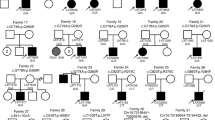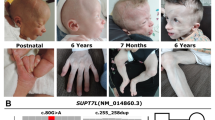Abstract
SHFM3 is a limb malformation characterized by the absence of central digits. It has been shown that this condition is associated with tandem duplications of about 500 kb at 10q24. The Dactylaplasia mice display equivalent limb defects and the two corresponding alleles (Dac 1j and Dac 2j) map in the region syntenic with the duplications in SHFM3. Dac 1j was shown to be associated with an insertion of an unspecified ETn-like mouse endogenous transposon upstream of the Fbxw4 gene. Dac 2j was also thought to be an insertion or a small inversion in intron 5 of Fbxw4, but the breakpoints and the exact molecular lesion have not yet been characterized. Here we report precise mapping and characterization of these alleles. We failed to identify any copy number differences within the SHFM3 orthologous genomic locus between Dac mutant and wild-type littermates, showing that the Dactylaplasia alleles are not associated with duplications of the region, in contrast with the described human SHFM3 cases. We further show that both Dac 1j and Dac 2j are caused by insertions of MusD retroelements that share 98% sequence identity. The differences between the nature of the human and mouse genomic abnormalities argue against models proposed so far that either envisioned SHFM3 as a local trisomy or Dac as a mutant allele of Fbxw4. Instead, both genetic conditions might lead to complex alterations of gene regulation mechanisms that would impair limb morphogenesis. Interestingly, the Dac 2j mutation occurs within a highly conserved element that may represent a regulatory sequence for a neighboring gene.



Similar content being viewed by others
References
Basel D, DePaepe A, Kilpattick MW, Tsipouras P (2003) Split hand-foot malformation is associated with a reduced level of Dactylin gene expression. Clin Genet 64(4):350–354
Baust C, Baillie GJ, Mager DL (2002) Insertional polymorphisms of ETn retrotransposons include a disruption of the wiz gene in C57BL/6 mice. Mamm Genome 13(8):423–428
Baust C, Gagnier L, Baillie GJ, Harris MJ, Juriloff DM et al (2003) Structure and expression of mobile ETnII retroelements and their coding-competent MusD relatives in the mouse. J Virol 77(21):11448–11458
Capdevila J, Izpisua Belmonte JC (2001) Patterning mechanisms controlling vertebrate limb development. Annu Rev Cell Dev Biol 17:87–132
Chai CK (1981) Dactylaplasia in mice: a two-locus model for development anomalies. J Hered 72(4):234–237
De Gobbi M, Viprakasit V, Hughes JR, Fisher C, Buckle VJ et al (2006) A regulatory SNP causes a human genetic disease by creating a new transcriptional promoter. Science 312(5777):1215–1217
de Mollerat XJ, Gurrieri F, Morgan CT, Sangiorgi E, Everman DB et al (2003) A genomic rearrangement resulting in a tandem duplication is associated with split hand-split foot malformation 3 (SHFM3) at 10q24. Hum Mol Genet 12(16):1959–1971
Dermitzakis ET, Reymond A, Antonarakis SE (2005) Conserved non-genic sequences - an unexpected feature of mammalian genomes. Nat Rev Genet 6(2):151–157
Guindon S, Gascuel O (2003) A simple, fast, and accurate algorithm to estimate large phylogenies by maximum likelihood. Syst Biol 52(5):696–704
Johnson KR, Lane PW, Ward-Bailey P, Davisson MT (1995) Mapping the mouse dactylaplasia mutation, Dac, and a gene that controls its expression, mdac. Genomics 29(2):457–464
Kano H, Kurahashi H, Tod T (2007) Genetically regulated epigenetic transcriptional activation of retrotransposon insertion confers mouse dactylaplasia phenotype. Proc Natl Acad Sci USA 104(48):19034–19039
Keller SA, Jones JM, Boyle A, Barrow LL, Killen PD et al (1994) Kidney and retinal defects (Krd), a transgene-induced mutation with a deletion of mouse chromosome 19 that includes the Pax2 locus. Genomics 23(2):309–320
Kent WJ (2002) BLAT—the BLAST-like alignment tool. Genome Res 12(4):656–664
Kleinjan DA, van Heyningen V (2005) Long-range control of gene expression: emerging mechanisms and disruption in disease. Am J Hum Genet 76(1):8–32
Kokubu C, Wilm B, Kokubu T, Wahl M, Rodrigo I et al (2003) Undulated short-tail deletion mutation in the mouse ablates Pax1 and leads to ectopic activation of neighboring Nkx2–2 in domains that normally express Pax1. Genetics 165(1):299–307
Lyle R, Radhakrishna U, Blouin JL, Gagos S, Everman DB et al (2006) Split-hand/split-foot malformation 3 (SHFM3) at 10q24, development of rapid diagnostic methods and gene expression from the region. Am J Med Genet A 140(13):1384–1395
Maksakova IA, Romanish MT, Gagnier L, Dunn CA, van de Lagemaat LN et al (2006) Retroviral elements and their hosts: insertional mutagenesis in the mouse germ line. PLoS Genet 2(1):e2
Moon AM, Capecchi MR (2000) Fgf8 is required for outgrowth and patterning of the limbs. Nat Genet 26(4):455–459
Pennacchio LA, Ahituv N, Moses AM, Prabhakar S, Nobrega MA et al (2006) In vivo enhancer analysis of human conserved non-coding sequences. Nature 444(7118):499–502
Reymond A, Henrichsen CN, Harewood L, Merla G (2007) Side effects of genome structural changes. Curr Opin Genet Dev 17(5):381–386
Ribet D, Dewannieux M, Heidmann T (2004) An active murine transposon family pair: retrotransposition of “master” MusD copies and ETn trans-mobilization. Genome Res 14(11):2261–2267
Rozen S, Skaletsky H (2000) Primer3 on the WWW for general users and for biologist programmers. In: Krawetz S, Misener S (eds) Bioinformatics methods and protocols: methods in molecular biology. Humana Press,Totowa, NJ, pp 365–386
Sidow A, Bulotsky MS, Kerrebrock AW, Birren BW, Altshuler D et al (1999) A novel member of the F-box/WD40 gene family, encoding dactylin, is disrupted in the mouse dactylaplasia mutant. Nat Genet 23(1):104–107
Smit A et al (2004) RepeatMasker Open-3.0, Institute for Systems Biology. Available at http://www.repeatmasker.org. Accessed Jan 2006
Acknowledgments
The authors thank Dr. Colette Rossier for sequencing and Fabienne Chabaud Barandun for management of the mouse colony. This work was funded by the Swiss National Science Foundation, NCCR “Frontiers in Genetics,” and the European Union AnEUploidy project.
Author information
Authors and Affiliations
Corresponding authors
Electronic supplementary material
Below is the link to the electronic supplementary material.
335_2008_9106_MOESM3_ESM.tif
Phylogenetic tree including the Dac mutations and related transposons. The tree was built using LTR sequence only (TIF 398 kb)
Rights and permissions
About this article
Cite this article
Friedli, M., Nikolaev, S., Lyle, R. et al. Characterization of mouse Dactylaplasia mutations: a model for human ectrodactyly SHFM3. Mamm Genome 19, 272–278 (2008). https://doi.org/10.1007/s00335-008-9106-0
Received:
Accepted:
Published:
Issue Date:
DOI: https://doi.org/10.1007/s00335-008-9106-0




